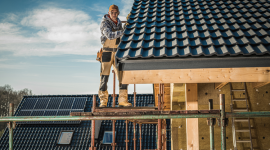A roof leak right after a heavy rain can cause a lot of stress. It’s frustrating to think everything is fine only to wake up to damp ceilings, drips in the hallway, or water spots down the wall. In Albuquerque, the rainy stretch that hits late summer can cause problems fast, especially if your roof already has some wear and tear. These leaks don’t always show up right away either. Water can sneak through small gaps and take time before showing any signs inside your home.
Roof leaks don’t always mean damage happened during the storm. It might be that the rain exposed something that was already wearing down—a stretched-out membrane, a shingle that’s worked loose, or water building up near clogged gutters. If you’ve had repeat leaks around the same spots, you’re likely dealing with more than one layer of the issue. It’s usually a sign your roofing system just isn’t draining or sealing the way it’s supposed to. And when it keeps raining, that leak gets bigger and harder to ignore.
Common Causes Of Roof Leaks After Heavy Rainfall
Heavy rain puts pressure on every weak spot a roof has. That downpour pushes water into cracks, around flashing, and under loose shingles. It can move faster than normal runoff systems can clear it, especially during Albuquerque’s summer storms when water comes down fast and hard. Here are the most common reasons why roofs spring leaks during that time:
1. Poor Installation: If parts of your roofing weren’t sealed or installed properly, water finds its way in through those little seams. Roofs are layered for a reason, and if those layers shift or were installed out of order, leaks happen.
2. Old or Deteriorating Shingles: Over time, shingles lose their grip and protection. When they crack, curl, or slide out of place, rain slips underneath and seeps into the wood beneath.
3. Damaged Flashing: The metal pieces that sit around chimneys, vents, and skylights need to be firmly sealed. If they crack or peel up, they leave gaps where rainwater slides in quietly.
4. Blocked Gutters and Downspouts: Water needs a place to go. If leaves or dirt pile up in gutters, that water spills over onto your roof and settles around edges it shouldn’t cover.
5. Punctures From Debris: Wind during storms can knock branches or objects onto your roof. Even something light can cause small cuts in the roofing material. Those holes can look harmless but still let water in.
One Albuquerque homeowner had leaks every monsoon season like clockwork. Turned out, flashing around one corner of their roof vent was missing completely. During light rains, nothing happened, but when big storms hit, water flooded the attic. The problem wasn’t obvious from the ground. It took climbing up and looking closely at the seams to spot it.
Leaks often come from more than one of these reasons stacked together. Poor drainage makes lifting shingles worse. Cracked seals speed up aging. That’s why regular inspections catch more than just one problem.
Identifying Signs Of Roof Leaks
Not every leak shows itself with a steady drip from the ceiling. Some signs can be slow and hard to notice. Knowing what to look for can help stop a small leak from turning into serious damage.
Look for these signs inside and outside your home:
1. Water Stains: Brown or yellow rings on the ceiling usually mean water has been sitting above that spot. It may dry out after the storm, but the damage doesn’t go away.
2. Damp or Peeling Walls: Paint bubbling or plaster starting to crack might trace back to a slow leak that’s settled behind the drywall.
3. Musty Smells: A soggy, basement-like smell coming from an attic or room is often a sign that water has snuck in and stayed long enough for mold to form.
4. Sagging Ceilings: If a ceiling feels droopy or soft, even if it looks dry, water may have soaked the insulation above it.
5. Mold or Mildew Around Roof Features: Places like skylights or ventilation fans are more likely to leak if their seals wear out. Mold near those spots is a red flag.
Outside, watch for missing shingles, drooping gutters, or puddles forming around one side of your house. If you see dark lines running down the outside walls, it could be water dripping where it shouldn’t.
It’s easy to ignore these hints in the middle of busy summer months, especially when the rain passes quickly. But even one rainy week is enough to turn a minor problem into a major repair job. Catching those little signs early makes it easier to fix before the next round of storms.
Preventive Measures To Avoid Roof Leaks
In a city like Albuquerque, where summer storms can roll in fast and unexpectedly, keeping your roof in good shape before the rain starts makes a big difference. While you can’t control the weather, you can reduce the risk of leaks with a few consistent habits. These don’t involve major changes, just regular upkeep and staying aware of your roof’s condition.
Start with simple inspections. Walk around your property and look up at your roofline and gutters. You don’t have to climb a ladder to notice that something’s off. Signs like sagging gutters, missing shingles, or debris piled on the roof can tell you it’s time for a closer look. After every major storm, or at least every few months, it’s smart to give your roof a once-over to catch early warning signs.
Gutters and downspouts are often overlooked, but they play a big role in preventing water buildup. When they’re full of leaves or dirt, rainwater can’t move where it’s supposed to. Instead, it pools around the edges of your roof or flows back underneath the shingles. Cleaning them out a few times each season is an easy step that saves you the headache of minor leaks becoming much larger problems.
Ventilation is another part homeowners sometimes miss. If your attic doesn’t breathe well, it traps moisture and heat, which can slowly weaken roofing materials from the inside. Insulation helps control the temperature, but airflow matters too. Vents near the eaves and along the roof ridge keep things balanced, especially during those sticky monsoon months.
To stay ahead of these problems:
– Schedule roof inspections yearly and after major storms if possible
– Check and clear your gutters every season
– Trim overhanging tree limbs that could scrape or drop debris on your roof
– Make sure attic spaces are ventilated and don’t feel damp or too hot
– Watch for moss, algae, or pooled water spots on your shingles
A regular maintenance plan doesn’t have to be complicated. It’s just about staying on top of small tasks that protect the bigger parts of your roofing system. Over time, these steps can help stretch the life of your roof and keep your home dry year after year.
Seeking Professional Help
Some roof problems just can’t be spotted from the ground or even fixed safely without the right tools. If you’ve seen the same stains, heard familiar drips, or noticed your ceiling changing color after storms, it’s time to call in a professional. That’s especially true after repeated leaks in one area or when rain seems to find its way in no matter what season it is.
Roofing experts know where to look for damage you might miss. They can spot weak spots that aren’t visible to the untrained eye, like damaged flashing around a vent or a seam where water is seeping in through the underlayment. They’ll also be able to tell if something is a quick patch or part of a bigger issue. Either way, getting the right fix now could keep you from dealing with ceiling replacements and waterlogged insulation later.
A trusted roofer will also take the guesswork out of what kind of repair or replacement is needed. Whether it’s sealing exposed nail holes, repairing flashing, reinforcing the underlayment, or reworking poor drainage, they’ll handle the job safely and quickly. Professional gear makes it possible to inspect places on the roof that are dangerous for homeowners to try to reach themselves.
Hiring someone early, before you’re dealing with buckets and water damage, makes a big difference in your long-term home care. A good roofing partner will give you peace of mind through Albuquerque’s wet months without leaving you wondering if another storm’s going to push water inside again.
Act Now So You Stay Dry Later
Roof leaks can feel like a constant game of catch-up if you don’t get ahead of them, especially with Albuquerque’s unpredictable storms. Staying alert to the early signs, like musty smells or ceiling spots, and taking simple steps like clearing gutters or trimming trees helps lower your odds of future damage. It doesn’t take a big storm to create a leak. Sometimes all it takes is one forgotten nail or a missing shingle to let water slip in.
Even if a roof looks fine from a distance, that doesn’t mean it’s sealed tight. Rain has a way of finding even the smallest gaps. Regular checkups and quick fixes go a long way in keeping your roof solid and your home dry.
With the rainy season landing right around mid to late August, now is the time to be proactive. Turning attention toward your roof today can prevent far bigger problems down the road. Whether it’s during a sunny weekend afternoon or right after a weather alert, taking a few steps now pays off when the clouds roll in again.
Rainy days shouldn’t dampen your spirits or your home. If you’re dealing with leaks or want to keep them at bay, consider the benefits of professional maintenance. Sol System Builders is here to support your needs with expert care. Learn how regular upkeep and inspections can help prevent future issues by exploring our approach to roofing for residential properties and keep your home protected through every season.





